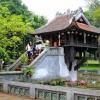Dear everyone
I obseved cooling water system in some refineries and see that they do not optimize the cooling water by throttling the outlet valve of each user, means that they keep vaves in fully open always during normal operation.
I understand that at the outlet of each user is provided a butterfly valve (most of cases) to control the CW flowrate depend on its process requirement (process temp).
If we optimize CW by throttling valves, we can save energy from pumps and can increase CW to users that need more water and reduce CW to users that need less CW.
However, I heard that if we reduce CW to user, it may get fouling due to low velocity and high outlet CW temperature.
In my refinery case: the return temp of CW header is only 35-36oC (Design supply/return temperature: Min (25/25oC), Normal (32/47oC) and Max (34/60oC)) and I think it is still low and the fouling may not be the concern.
Another concern is low velocity, even there is no flow indicator at each user but base on the total actual flow rate of CW compared to design I think it must be higher than velocity as designed.
Please share your experience/application of CW optimization.
1. SHould we optimize the CW system by throttling the outlet valve of each user?
2. Tthe minimum velocity of water side that can be acceptable while fouling issue is minimized?
3.Tthe max water temp that can cause fouling?
Thanks and best regards

 FB
FB











